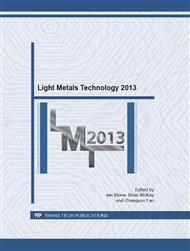p.612
p.618
p.623
p.629
p.634
p.639
p.644
p.648
p.653
Improving Corrosion Resistance of AA2014 Welds with Micro Arc Oxidation
Abstract:
Autogenous single pass full penetration welds of 2.8 mm thick AA 2014 plates were produced by un-pulsed and pulsed gas tungsten arc welding (GTAW) process. In pulsed current mode, two levels of pulsing viz., 3 and 6 Hz were employed. In order to improve the corrosion resistance of weld metals, micro arc oxidation (MAO) treatment was given in aqueous silicate solution containing either borax or tungstate. The MAO treatment was carried out for 10, 20 and 30 minutes. Irrespective of the electrolyte composition, surface roughness increased with increasing treatment duration. However, the effect was observed to be significant with borax addition. X-ray diffraction studies showed that γ-Al2O3 content in the coating continued to increase up to 20 minutes and for the coating produced with 30 minutes duration the α-Al2O3 content was found to be more than γ-Al2O3. The coating treated for 30 minutes exhibited relatively poorer corrosion resistance than the other coated specimens. The better corrosion resistance offered by the coating obtained after 20 minutes, compared with the other coatings, could be attributed to the nature of the oxide and its content. Even though tungstate addition improved hardness of the coating, borax addition was found to enhance the corrosion resistance.
Info:
Periodical:
Pages:
634-638
Citation:
Online since:
July 2013
Authors:
Price:
Сopyright:
© 2013 Trans Tech Publications Ltd. All Rights Reserved
Share:
Citation:


